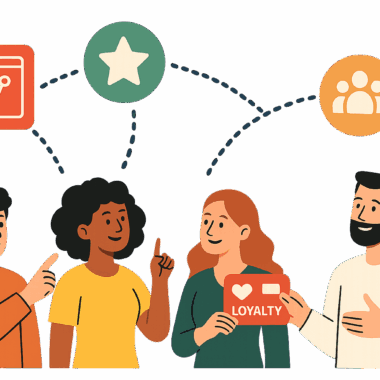

Cross-Channel Partnerships: Combining Affiliates, Loyalty Programs & Communities for Growth

Content:
- The Evolution of Affiliate and Partnership Marketing
- The Power of Cross-Channel Integration
- Building a Unified Partnership Framework
- The Role of Loyalty Programs in Affiliate Growth
- Communities as a Catalyst for Sustainable Partnerships
- Technology and Data in Cross-Channel Partnership Management
- Conclusion
- Frequently Asked Questions (FAQ)
In today’s fragmented digital ecosystem, businesses must connect performance, engagement, and loyalty into one unified strategy. Cross-channel partnerships are emerging as a key growth mechanism for brands that want to align affiliates, loyalty programs, and brand communities under a single framework. This integration ensures consistent user experience, transparent measurement, and stronger long-term relationships with partners and consumers.
By merging these channels, brands can leverage multiple touchpoints—from referral links and reward systems to social interactions—to build sustainable revenue streams. The goal is not only to drive conversions but also to create ecosystems where partners and customers co-create value. In this article, we explore how cross-channel collaboration can redefine performance marketing in 2026 and beyond.
The Evolution of Affiliate and Partnership Marketing
Affiliate marketing has evolved from a simple commission-based model into a data-driven ecosystem where relationships and long-term engagement matter as much as performance metrics. Modern affiliate programs now incorporate influencers, content creators, and community advocates, forming a comprehensive partnership model.
The shift toward hybrid partnership ecosystems is driven by changing consumer expectations and the need for transparency. Loyalty systems and community-driven initiatives now complement affiliate channels, blending transactional and emotional engagement. This evolution requires brands to focus on integration, data synchronization, and shared value creation.
The Power of Cross-Channel Integration
Cross-channel integration bridges the gap between acquisition, retention, and advocacy. When affiliates, loyalty programs, and communities operate together, they create a seamless customer journey across multiple digital environments.
Integrated ecosystems allow data to flow freely between platforms, improving personalization and attribution accuracy. Research from Forrester shows that brands with unified partnership systems experience up to 30% higher customer retention and 25% greater lifetime value compared to isolated channels. This synergy turns disconnected efforts into an efficient growth engine.
Core advantages of cross-channel strategies:
- Unified data and customer insights.
- Stronger partner alignment and engagement.
- Improved ROI through shared objectives.
- Enhanced user experience across touchpoints.
Building a Unified Partnership Framework
Developing a cross-channel partnership strategy requires systematic alignment of incentives, technologies, and measurement systems. Each partner type—affiliates, loyalty platforms, and communities—must contribute to a shared set of performance and engagement goals.
The process begins with identifying overlapping audiences and value exchanges between channels. A unified partnership structure should balance financial incentives with experiential rewards, promoting sustainable engagement. Centralized tracking and attribution are essential to ensure transparency and consistent evaluation.
Steps to build a unified framework:
- Map audience overlap and shared objectives.
- Align incentive models across affiliate and loyalty systems.
- Use a centralized analytics platform for performance tracking.
- Standardize partner onboarding, policies, and KPIs.
- Continuously audit engagement metrics and community activity.
The Role of Loyalty Programs in Affiliate Growth
Loyalty programs enhance the affiliate marketing ecosystem by driving repeat engagement and reinforcing brand affinity. Instead of relying solely on one-time transactions, brands can use reward points, cashback, or tier-based systems to encourage ongoing interactions.
Modern loyalty solutions are increasingly integrated with affiliate networks. For example, affiliates can promote offers that earn both cash rewards and loyalty points, creating a dual incentive mechanism. This hybrid model aligns short-term performance with long-term customer retention, strengthening the relationship between brands, affiliates, and end-users.
Key mechanisms for loyalty-driven affiliate models:
- Unified reward currencies across campaigns.
- Gamified challenges with performance tiers.
- Integration with referral and influencer programs.
- Automated redemption and reward tracking through APIs.
Communities as a Catalyst for Sustainable Partnerships
Communities play a pivotal role in shaping trust, advocacy, and peer influence. In a cross-channel environment, they act as amplifiers for brand messaging and as real-time feedback loops that guide partnership optimization.
Engaged communities generate authentic user-generated content (UGC), increasing credibility and conversion rates. Brands that actively invest in community partnerships see stronger organic engagement and lower acquisition costs. This dynamic fosters sustainable, long-term growth rather than short-lived promotional spikes.
Benefits of community-integrated partnerships:
- Increased brand authenticity and transparency.
- Real-time insights into audience sentiment.
- Higher social sharing and referral activity.
- Greater resilience through organic advocacy.
Technology and Data in Cross-Channel Partnership Management
Data unification is the backbone of any successful cross-channel partnership. CRM, CDP, and AI-powered analytics enable marketers to consolidate behavioral, transactional, and engagement data across channels.
This integration facilitates accurate attribution and predictive modeling. It also helps brands personalize partner interactions, automate workflows, and monitor compliance at scale. As privacy regulations evolve, privacy-first data management becomes critical for maintaining user trust and ethical performance tracking.
Technological enablers include:
- Centralized customer data platforms (CDPs).
- AI-driven multi-touch attribution systems.
- Secure APIs for partner integrations.
- Consent management and privacy compliance tools.
|
Technology |
Primary Function |
Impact on Partnerships |
| CRM Systems | Manage partner relationships and engagement history. | Enhances retention and satisfaction. |
| AI Attribution | Tracks customer journeys and assigns credit to each touchpoint. | Improves transparency and ROI accuracy. |
| CDP Platforms | Aggregate and normalize customer data across channels. | Enables unified insights and personalization. |
Conclusion
Cross-channel partnerships redefine how brands, affiliates, and communities collaborate for growth. By integrating performance marketing, loyalty, and community engagement, businesses can build ecosystems that combine profitability with sustained customer relationships.
In the coming years, success will depend on the ability to unify these channels under data-driven strategies and ethical frameworks. Organizations that adopt transparent, collaborative, and customer-centric partnership models will lead the next wave of digital marketing innovation.
Frequently Asked Questions (FAQ)
1. What are cross-channel partnerships in marketing?
They are integrated frameworks that combine affiliates, loyalty programs, and communities into a single growth ecosystem with shared data and performance metrics.
2. How do affiliates and loyalty programs complement each other?
Affiliates drive acquisition, while loyalty programs enhance retention. Together, they create a continuous engagement loop that maximizes customer lifetime value.
3. What tools are essential for managing cross-channel data?
CRM, CDP, and AI attribution tools are key for tracking, analyzing, and optimizing partner performance across multiple channels.
4. How can communities strengthen partnership marketing?
Communities drive advocacy, generate user-generated content, and enhance brand trust, which amplifies affiliate and loyalty performance.
5. What KPIs should brands track in cross-channel strategies?
Brands should monitor customer retention rate, engagement metrics, cross-channel ROI, partner satisfaction, and conversion velocity.

Comparison of the Top 15 Affiliate Software Solutions for the iGaming Industry
This article evaluates 15 top-tier affiliate platforms, offering insights into their architecture, feature sets, and pricing transparency. The goal is to guide iGaming operators—whether startups or established brands—toward data-driven decisions. Tools such as a casino affiliate software or gambling affiliate marketing software can provide the performance analytics operators need.

How to Track Affiliate Traffic and Conversions in the iGaming Industry
Accurate affiliate tracking directly impacts commission payments, campaign optimization, and regulatory reporting. Given the complex tech stacks, multi-brand operations, and geo-specific restrictions in iGaming, proper tracking is both more challenging and more essential than in traditional verticals. This article explores how to structure affiliate tracking in a way that supports transparency, scale, and growth.

Real-Time Lead Distribution vs. Manual Assignment: Pros & Cons
This article analyzes the differences between real-time lead distribution and manual assignment, focusing on their operational efficiency, scalability, and accuracy. Understanding the strengths and weaknesses of each model helps sales leaders select the best approach for their organization’s size, structure, and technological maturity.



